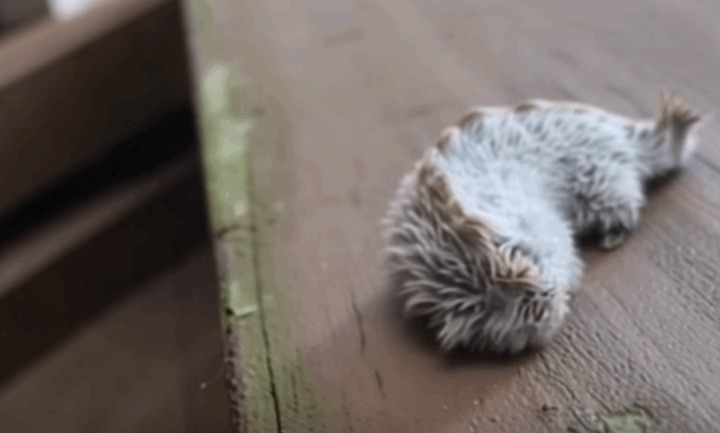It was one of those golden afternoons that make the world feel calm and unhurried. The kind of day when the sunlight seems to rest softly on every leaf, and even time itself feels like it’s taking a deep breath. In Gwinnett County, Georgia, the air carried the scent of freshly cut grass and distant barbecues, and the sound of children’s laughter echoed across the park. For Leslie Howe and her three children, it was supposed to be an ordinary Saturday—a quiet escape from errands, screens, and the pace of everyday life.
The family had spent the morning running around the playground, chasing bubbles, and feeding ducks near the pond. When they finally settled on a weathered bench under a tall oak tree, Leslie felt that small, perfect moment every parent hopes for—a few seconds of peace. She set the diaper bag down beside her, handed each child a juice box, and smiled at how the sunlight danced across the ground.
But peace, as nature often reminds us, can be fragile.
An Innocent Discovery
It started with a child’s curiosity, as so many stories do.
“Mommy, look! A fuzzy bug!” Leslie’s youngest, Ellie, squealed with delight.
Leslie turned to see what her daughter was pointing at. Resting on the wooden slat beside her was a tiny ball of golden fur, no bigger than her thumb. At first glance, it looked harmless—almost cute. Maybe a piece of a stuffed animal left behind by another child. But then it moved.
The small, rounded shape rippled ever so slightly, as if breathing. It inched forward with an odd gliding motion that didn’t quite match any bug Leslie had ever seen. Her children leaned in with wide eyes, fascinated by what they imagined was a tiny, magical creature.
Leslie instinctively stretched out her arm to stop them.
“Don’t touch,” she said gently. “Let’s just look.”
Her voice carried the calm firmness of a mother who has learned that curiosity, while beautiful, needs boundaries.
Beauty in Disguise
The creature shimmered in the sunlight, its silky coat catching the light in golden threads. It didn’t look like a caterpillar at all—more like a miniature animal with soft fur, the sort of thing a child might imagine in a fairy tale. Its body moved slowly, gliding along the surface of the bench, unaware of the attention it had gathered.
The children whispered theories.
“Maybe it’s a baby squirrel!”
“Or a bug in a costume!”
“Can we keep it, Mommy?”
Leslie smiled, but something inside her stirred—a quiet, uneasy feeling that told her something wasn’t quite right. Parenthood had sharpened her instincts in ways she didn’t always understand. She had learned to trust that faint signal that said, Wait. Don’t rush.
So instead of dismissing her hesitation, she pulled out her phone and took a picture.
That single photograph would later reveal how close her family had come to an unexpected danger hiding beneath the illusion of softness.
The Hidden Danger
Later that evening, after the children were tucked into bed, Leslie uploaded the photo to a local nature group on social media. Within minutes, her post began to attract attention.
“That’s a Puss Caterpillar!” one user commented. “Be careful—those things sting!”
Another added, “They’re common in Georgia this time of year. Tell your kids not to touch them!”
Leslie blinked at the screen, surprised. She had never heard of such a creature. Curious and slightly concerned, she began reading through the replies. Some users shared stories, others linked to articles, and one person even uploaded a photo of a red, swollen arm as a cautionary example.
It turned out the “fuzzy bug” wasn’t harmless at all. It was one of the most venomous caterpillars in North America.
The Puss Caterpillar, also known as the Southern Flannel Moth larva, is covered in what looks like soft fur—but beneath that silky layer are venomous spines capable of delivering a powerful sting. Experts describe the pain as intense, often compared to multiple wasp stings at once. For some, the reaction can cause burning, swelling, nausea, and even fever.
Leslie sat back in shock. That adorable little creature her daughter wanted to pet could have turned a peaceful afternoon into a trip to the emergency room.
Understanding the Puss Caterpillar
Curiosity quickly turned into research. Leslie began reading about the species, learning that it thrives in the southern United States, especially in states like Georgia, Florida, and Texas.
According to information from state forestry departments and entomologists, the Puss Caterpillar appears mostly during late summer and early fall. It prefers shaded areas—parks, gardens, and backyards—and often hides on tree trunks, fences, and outdoor furniture. Because it blends in so easily, it’s common for people to mistake it for a bit of fluff or a leaf.
When disturbed, the caterpillar’s venomous spines can pierce the skin through contact. Most stings are not life-threatening but can cause intense discomfort, including redness, blisters, and radiating pain. For children, elderly people, or those with allergies, medical attention is advised immediately.
In some states, local park services even post warning signs during the months when these insects are most active.
A Mother’s Instinct: The First Line of Defense
What struck Leslie most wasn’t just how deceptive the caterpillar looked—it was how close she and her children had come to danger without realizing it.
“It looked like a toy,” she said later in an interview. “If I hadn’t stopped them, one of my kids would’ve touched it. I didn’t even know such a thing existed, but something in me said to wait.”
That instinct, that small protective voice, became the unspoken hero of the story.
For parents, intuition often works faster than logic. It’s the subconscious wisdom that forms after countless moments of experience—the scraped knees, the allergic reactions, the late-night fevers. Leslie’s decision to pause, to question, made all the difference.
A Teachable Moment for the Community
As Leslie’s post spread across local groups, other parents began sharing similar stories. A few had spotted the same caterpillar in their own neighborhoods. One family reported that their teenage son brushed against one on a tree trunk and developed a painful rash that lasted for days.
Soon, park officials took notice. Signs appeared near benches and playground areas, warning visitors to be cautious and to avoid touching unknown insects. What began as one mother’s simple social media post had evolved into a small but meaningful public awareness effort.
Local newspapers picked up the story, framing it not as a tale of danger but as one of education and mindfulness.
Nature, after all, is full of contrasts. What looks gentle can sometimes be harmful, and what looks frightening can sometimes be harmless. Awareness bridges that gap.
Lessons Beyond the Park
In the days that followed, Leslie noticed a change in her children. They couldn’t stop talking about “the fuzzy bug,” but their curiosity had matured. Instead of wanting to touch everything they found, they began asking questions.
They watched documentaries about insects that use camouflage to protect themselves. They learned about the difference between mimicry and defense. They even drew pictures of the Puss Caterpillar, labeling its “fluffy armor” and its hidden spines.
What had begun as a near-miss became an unforgettable science lesson.
“It taught them respect,” Leslie said. “Not fear—just respect. You can admire nature, but you have to understand it, too.”
Balancing Curiosity and Caution
Children are naturally curious. They explore the world through touch, sight, and endless questions. But as every parent knows, that curiosity sometimes needs a safety net.
Encounters like Leslie’s remind us that curiosity and caution can coexist. In fact, they complement each other. When children learn that some creatures are best admired from a distance, they also learn empathy—for the small, the wild, and the fragile.
Education plays a vital role here. Schools, nature centers, and parents can all help children identify local wildlife, teaching which insects are safe to handle and which ones should be avoided. Encouraging outdoor exploration doesn’t mean removing risk entirely—it means teaching awareness and responsibility.
Nature’s Subtle Reminders
The story of the Puss Caterpillar is not one of fear but of perspective. It shows that beauty and danger can share the same space. Nature doesn’t hide its lessons; it simply asks us to look closer.
For Leslie, the experience reinforced something she already knew deep down—that a mother’s intuition is often the most reliable compass there is. Science can explain the facts, but instinct protects us in the moments before logic catches up.
Her story spread not because it was dramatic, but because it was relatable. Every parent has felt that sudden tug of concern, that moment when something looks “off.” Most of the time, those instincts prove right.
The Return to the Park
A few weeks later, the Howe family returned to the same park. The sun was shining again, and the familiar oak tree still offered its generous shade. As the children played, Ellie spotted a butterfly perched delicately on a flower.
She took a small step forward, then looked up at her mother.
“Can I touch it, or should I just look?” she asked.
Leslie smiled. “Just look, sweetheart. Sometimes the best way to love something wild is to let it be.”
That exchange, simple and pure, captured everything the family had learned. Caution didn’t have to limit their wonder—it simply shaped it into something wiser.
A Broader Lesson for Everyone
Stories like Leslie’s carry an important reminder for all of us. Whether we are parents, teachers, or simply nature lovers, awareness and respect go hand in hand.
The natural world isn’t divided into “safe” and “dangerous.” It’s a spectrum of coexistence, where every organism has its own defenses and roles. The Puss Caterpillar, for example, doesn’t sting out of malice—it defends itself the only way it knows how.
Understanding that balance encourages compassion. When we teach children to appreciate animals—even the ones that sting, bite, or scare us—we’re nurturing empathy for life in all its forms.
Why AdSense-Friendly Awareness Content Matters
From a digital media perspective, stories like this demonstrate how meaningful, positive storytelling can align perfectly with AdSense policies. They avoid shock value, focus on education, and encourage safe, respectful engagement with the world.
Educational content that informs readers about real-life safety lessons—without exaggeration or fearmongering—creates value for audiences and advertisers alike. Articles like Leslie’s experience appeal to families, educators, and general readers who seek informative, trustworthy content.
By keeping the tone neutral, factual, and family-friendly, such stories build community awareness while staying fully compliant with online publishing standards.
Conclusion: The Power of Intuition and Awareness
Leslie’s story isn’t just about a caterpillar—it’s about instinct, awareness, and the quiet power of paying attention.
In an age where we often rely on search results and instant information, it’s easy to forget that human intuition still plays a vital role in safety and understanding. Technology can inform us, but instinct can protect us in the moment.
The fuzzy little caterpillar under that oak tree was more than a curiosity—it was a reminder that every living thing carries a lesson. For the Howes, it became a symbol of mindfulness.
Nature, in all its beauty and complexity, doesn’t exist to scare us. It invites us to see, to learn, and to remember that respect is the bridge between wonder and wisdom.
As Leslie later reflected, “It wasn’t about fear. It was about listening—to that small voice that says, Wait. That voice might just be the reason we’re safe today.”
And perhaps that’s the quiet truth of her story: that sometimes, the sharpest lessons come wrapped in silk—and the softest warnings arrive on golden afternoons.




